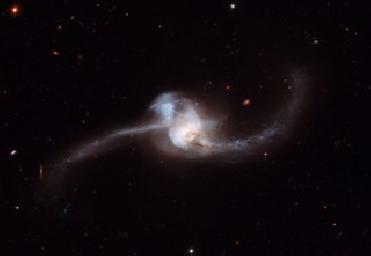
The NGC 2623 taken by Hubble. Image credit: NASA/ESA Hubble Space Centre
WASHINGTON (BNS): The Hubble Space Telescope has recently captured a “bright and bizarre” galaxy which is indeed the result of a pair of spiral galaxies smashing at breakneck speed in the constellation of Cancer.
The product of this “dramatic collision” of the Milky Way-resembling galaxies, named NGC 2623, is about 250 million light-years away in the constellation of Cancer. The new image sheds light on the remarkable effect interacting galaxies have on each other when they collide, according to the ESA/Hubble information centre.
Studies have shown that as galaxies approach one another, massive amounts of gas are pulled from each galaxy towards the centre of another, until ultimately the two merge into one massive galaxy.
The object in the image NGC 2623 is in the late stages of merger process with the centres of the original galaxy pair now merged into one nucleus.
However, stretching out from the centre are two tidal tails of young stars, showing that a merger has taken place. During such a collision, the dramatic exchange of mass and gases initiates star formation, as seen here in both the tails.
The prominent lower tail is richly populated with bright star clusters – 100 of them have been found in these observations. The large star clusters the scientist’ team has observed in the merged galaxy are brighter than the brightest clusters we see in our own vicinity.
These star clusters may have formed as part of a loop of stretched material associated with the northern tail, or they may have formed from debris falling back onto the nucleus. In addition to this active star-forming region, both galactic arms harbour very young stars in the early stages of their evolutionary journey.
Some mergers, including NGC 2623, can result in an active galactic nucleus, where one of the supermassive black holes found at the centres of the two original galaxies is stirred into action. Matter is pulled toward the black hole, forming an accretion disc. The energy released by the frenzied motion heats up the disc, causing it to emit across a wide swath of the electromagnetic spectrum.
The new-found galaxy is so bright in the infrared that it belongs to the group of very luminous infrared galaxies (LIGR) and has been extensively studied as part of the Great Observatories All-sky LIRG Survey (GOALS) project that combines data from some of the most advanced space-based telescopes, including Hubble.
Additional data from infrared and X-ray telescopes can further characterise objects like active galactic nuclei and nuclear star formation by revealing what is unseen at visible wavelengths.
 Previous Article
Previous Article Next Article
Next Article













The Indian Air Force, in its flight trials evaluation report submitted before the Defence Ministry l..
view articleAn insight into the Medium Multi-Role Combat Aircraft competition...
view articleSky enthusiasts can now spot the International Space Station (ISS) commanded by Indian-American astr..
view article